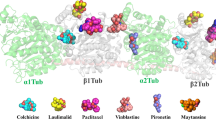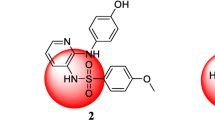Abstract
Microtubules (made up of α and β-tubulin subunits) play an essential role in the process of mitosis and cell proliferation, thus making them an ideal target for anticancer drugs discovery. Microtubule-targeted drugs, including taxanes and vinca alkaloids, can suppress microtubule dynamics, cause mitotic block and apoptosis, which have been widely used in the treatment of various cancers. There are three unique binding sites (taxanes, vinca alkaloids, and colchicine) in tubulin can be targeted to develop tubulin inhibitors. In this study, we selected the colchicine binding site in tubulin as our target. By performing molecular docking-based virtual screening combined with in vitro tubulin polymerization inhibition assay, we identified two novel and potent tubulin inhibitors (9 and 19). These two compounds arrested cell cycle progression at the G2/M phase and induced apoptosis at sub μM concentrations. In addition, they displayed potent antiproliferative activity with IC50 values in the nM range. Finally, the probable binding modes of 9 and 19 were probed by molecular docking. These two compounds with novel scaffold will shed new light on the lead molecules discovery and the design of new microtubule-targeting agents (MTAs).





Similar content being viewed by others
References
Hanahan D, Weinberg RA (2000) The hallmarks of cancer. Cell 100(1):57–70
Hanahan D, Weinberg RA (2011) Hallmarks of cancer: the next generation. Cell 144(5):646–674. https://doi.org/10.1016/j.cell.2011.02.013
Jordan A, Hadfield JA, Lawrence NJ, McGown AT (1998) Tubulin as a target for anticancer drugs: agents which interact with the mitotic spindle. Med Res Rev 18(4):259–296
Desai A, Mitchison TJ (1997) Microtubule polymerization dynamics. Annu Rev Cell Dev Biol 13:83–117. https://doi.org/10.1146/annurev.cellbio.13.1.83
Olziersky AM, Labidi-Galy SI (2017) Clinical development of anti-mitotic drugs in cancer. Adv Exp Med Biol 1002:125–152. https://doi.org/10.1007/978-3-319-57127-0_6
Jordan MA, Wilson L (2004) Microtubules as a target for anticancer drugs. Nat Rev Cancer 4(4):253–265. https://doi.org/10.1038/nrc1317
Negi AS, Gautam Y, Alam S, Chanda D, Luqman S, Sarkar J, Khan F, Konwar R (2015) Natural antitubulin agents: importance of 3,4,5-trimethoxyphenyl fragment. Bioorg Med Chem 23(3):373–389. https://doi.org/10.1016/j.bmc.2014.12.027
Li L, Jiang S, Li X, Liu Y, Su J, Chen J (2018) Recent advances in trimethoxyphenyl (TMP) based tubulin inhibitors targeting the colchicine binding site. Eur J Med Chem 151:482–494. https://doi.org/10.1016/j.ejmech.2018.04.011
Manglik A, Lin H, Aryal DK, McCorvy JD, Dengler D, Corder G, Levit A, Kling RC, Bernat V, Hubner H, Huang XP, Sassano MF, Giguere PM, Lober S, Da D, Scherrer G, Kobilka BK, Gmeiner P, Roth BL, Shoichet BK (2016) Structure-based discovery of opioid analgesics with reduced side effects. Nature 537(7619):185–190. https://doi.org/10.1038/nature19112
Mao R, Shao J, Zhu K, Zhang Y, Ding H, Zhang C, Shi Z, Jiang H, Sun D, Duan W, Luo C (2017) Potent, selective, and cell active protein arginine methyltransferase 5 (PRMT5) inhibitor developed by structure-based virtual screening and hit optimization. J Med Chem 60(14):6289–6304. https://doi.org/10.1021/acs.jmedchem.7b00587
Ye Y, Zhang B, Mao R, Zhang C, Wang Y, Xing J, Liu YC, Luo X, Ding H, Yang Y, Zhou B, Jiang H, Chen K, Luo C, Zheng M (2017) Discovery and optimization of selective inhibitors of protein arginine methyltransferase 5 by docking-based virtual screening. Org Biomol Chem 15(17):3648–3661. https://doi.org/10.1039/c7ob00070g
Meng F, Cheng S, Ding H, Liu S, Liu Y, Zhu K, Chen S, Lu J, Xie Y, Li L, Liu R, Shi Z, Zhou Y, Liu YC, Zheng M, Jiang H, Lu W, Liu H, Luo C (2015) Discovery and optimization of novel, selective histone methyltransferase SET7 inhibitors by pharmacophore- and docking-based virtual screening. J Med Chem 58(20):8166–8181. https://doi.org/10.1021/acs.jmedchem.5b01154
Zhang J, Liu H, Zhu K, Gong S, Dramsi S, Wang YT, Li J, Chen F, Zhang R, Zhou L, Lan L, Jiang H, Schneewind O, Luo C, Yang CG (2014) Antiinfective therapy with a small molecule inhibitor of Staphylococcus aureus sortase. Proc Natl Acad Sci USA 111(37):13517–13522. https://doi.org/10.1073/pnas.1408601111
Kang JS, Zhang AL, Faheem M, Zhang CJ, Ai N, Buynak JD, Welsh WJ, Oelschlaeger P (2018) Virtual screening and experimental testing of B1 metallo-beta-lactamase Inhibitors. J Chem Inf Model. https://doi.org/10.1021/acs.jcim.8b00133
Mok SWF, Zeng W, Niu Y, Coghi P, Wu Y, Sin WM, Ng SI, Gordillo-Martinez F, Gao JY, Law BYK, Liu L, Yao X, Wong VKW (2018) A method for rapid screening of anilide-containing AMPK modulators based on computational docking and biological validation. Front Pharmacol 9:710. https://doi.org/10.3389/fphar.2018.00710
Zhu K, Jiang C, Tao H, Liu J, Zhang H, Luo C (2018) Identification of a novel selective small-molecule inhibitor of protein arginine methyltransferase 5 (PRMT5) by virtual screening, resynthesis and biological evaluations. Bioorg Med Chem Lett 28(9):1476–1483. https://doi.org/10.1016/j.bmcl.2018.03.087
Wang J, Luo C, Shan C, You Q, Lu J, Elf S, Zhou Y, Wen Y, Vinkenborg JL, Fan J, Kang H, Lin R, Han D, Xie Y, Karpus J, Chen S, Ouyang S, Luan C, Zhang N, Ding H, Merkx M, Liu H, Chen J, Jiang H, He C (2015) Inhibition of human copper trafficking by a small molecule significantly attenuates cancer cell proliferation. Nat Chem 7(12):968–979. https://doi.org/10.1038/nchem.2381
Huey R, Morris GM, Olson AJ, Goodsell DS (2007) A semiempirical free energy force field with charge-based desolvation. J Comput Chem 28(6):1145–1152. https://doi.org/10.1002/jcc.20634
Olson GMMDSGRSHRHWEHRKBAJ (1998) Automated docking using a Lamarckian genetic algorithm and an empirical binding free energy function. J Comput Chem 19(14):24
Prota AE, Danel F, Bachmann F, Bargsten K, Buey RM, Pohlmann J, Reinelt S, Lane H, Steinmetz MO (2014) The novel microtubule-destabilizing drug BAL27862 binds to the colchicine site of tubulin with distinct effects on microtubule organization. J Mol Biol 426(8):1848–1860. https://doi.org/10.1016/j.jmb.2014.02.005
Zhai Y, Kronebusch PJ, Simon PM, Borisy GG (1996) Microtubule dynamics at the G2/M transition: abrupt breakdown of cytoplasmic microtubules at nuclear envelope breakdown and implications for spindle morphogenesis. J Cell Biol 135(1):201–214
Acknowledgements
This research was supported by a grant from the Chia Tai Tianqing Pharmaceutical Group Co., Ltd. (YWJKJJHKYJJ-Q1115).
Author information
Authors and Affiliations
Corresponding author
Additional information
Publisher's Note
Springer Nature remains neutral with regard to jurisdictional claims in published maps and institutional affiliations.
Electronic supplementary material
Below is the link to the electronic supplementary material.
Rights and permissions
About this article
Cite this article
Liu, G., Jiao, Y., Huang, C. et al. Identification of novel and potent small-molecule inhibitors of tubulin with antitumor activities by virtual screening and biological evaluations. J Comput Aided Mol Des 33, 659–664 (2019). https://doi.org/10.1007/s10822-019-00206-y
Received:
Accepted:
Published:
Issue Date:
DOI: https://doi.org/10.1007/s10822-019-00206-y




